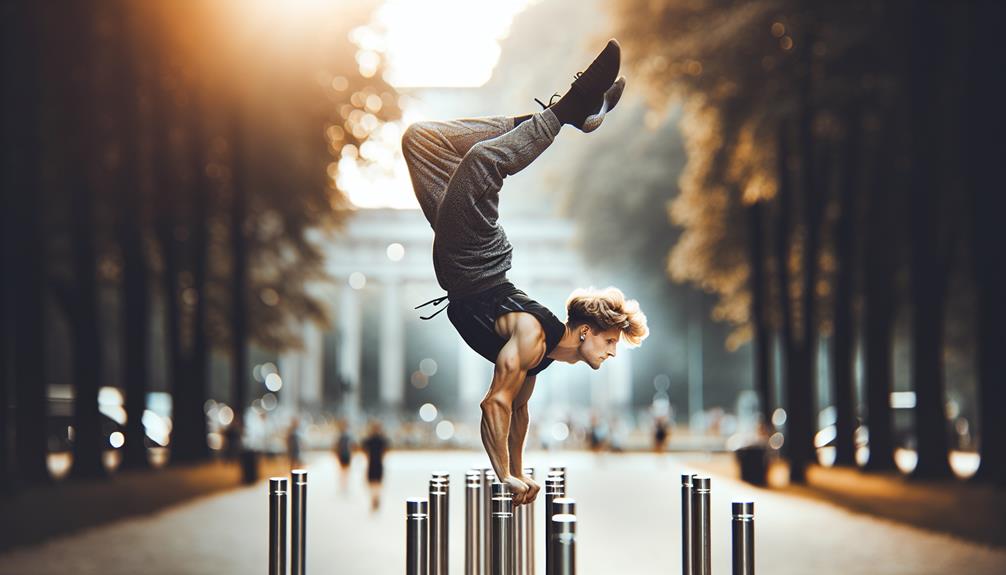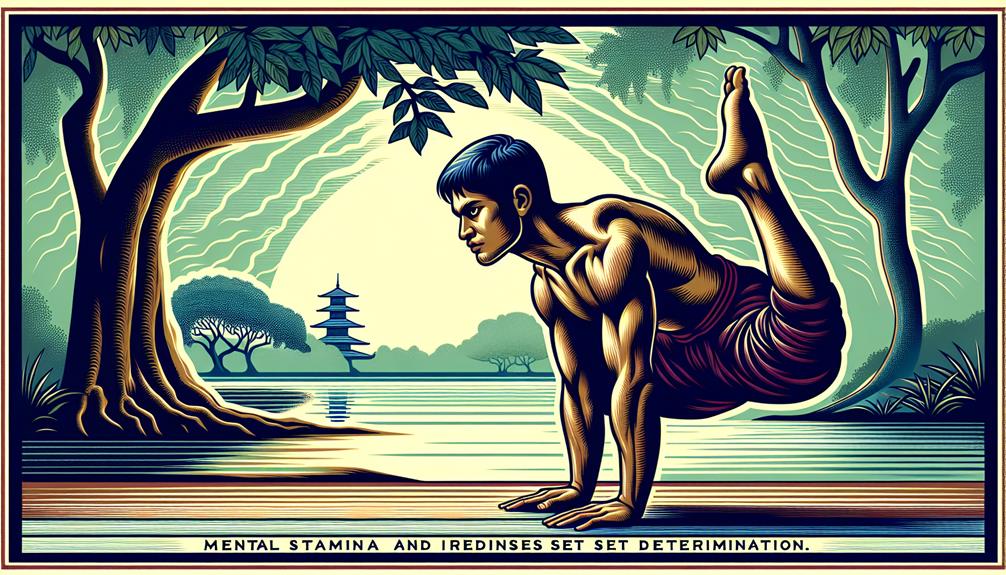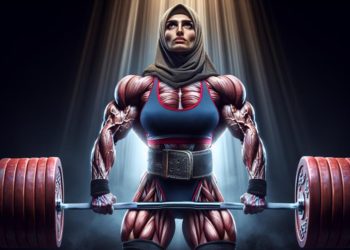Step into the world of calisthenics and prepare to be mesmerized by the Masters of Bodyweight Mastery. These individuals have honed their skills, sculpting their bodies and minds into instruments of strength and discipline. With their astonishing feats of power and grace, they push the boundaries of what the human body is capable of achieving. But what sets these masters apart from the rest? How do they unlock the secrets of calisthenics and become true masters of their craft? Prepare to be captivated as we unravel the stories of these extraordinary individuals and delve into the depths of their bodyweight mastery.
Key Takeaways
- Calisthenics originated in ancient Greece and has evolved over time to become a popular form of exercise worldwide.
- Progressive overload and variations of exercises are essential for building bodyweight strength.
- Mastering calisthenics techniques, such as balance and handstands, unlocks the potential for advanced movements.
- Flexibility training and a strong mindset are crucial for achieving bodyweight mastery in calisthenics.
The Early Beginnings of Calisthenics
The early beginnings of calisthenics can be traced back to ancient Greece, where physical fitness and strength were highly valued. Calisthenics, derived from the Greek words "kalos" meaning beauty and "sthenos" meaning strength, was a fundamental part of Greek culture. The evolution of calisthenics techniques can be attributed to various factors, with one of the most significant influences being gymnastics.
Gymnastics, developed by the ancient Greeks, played a vital role in shaping the early forms of calisthenics. It encompassed a wide range of exercises and movements that focused on developing strength, flexibility, and balance. These gymnastic exercises formed the foundation of calisthenics, incorporating elements such as bodyweight exercises, static holds, and dynamic movements.
Over time, calisthenics techniques evolved and adapted to cater to different training goals and preferences. From the ancient Greek era to the present day, calisthenics has become a popular form of exercise worldwide. It offers a versatile and accessible means of achieving strength, mobility, and overall fitness.
Today, the influence of gymnastics on calisthenics remains evident. Many calisthenics practitioners incorporate gymnastic elements into their training routines, such as handstands, muscle-ups, and levers. This fusion of gymnastics and calisthenics has led to the development of impressive bodyweight skills and showcases the limitless potential of the human body.
Pushing the Limits: Unleashing Bodyweight Strength
Unleash the full potential of your bodyweight strength by pushing the limits of what you thought was possible. With bodyweight progressions, you can build functional strength that will not only improve your physical performance but also enhance your overall well-being. Here are four ways to take your bodyweight training to the next level:
- Progressive Overload: Gradually increase the difficulty of your exercises by adding more repetitions, sets, or intensity. This challenges your muscles and forces them to adapt and grow stronger.
- Variations: Explore different variations of exercises to target specific muscle groups and challenge your body in new ways. For example, instead of regular push-ups, try one-arm push-ups or decline push-ups to engage your muscles differently.
- Plyometrics: Incorporate explosive movements like jump squats, clap push-ups, or box jumps to improve power and speed. These dynamic exercises not only build strength but also enhance your agility and coordination.
- Isometric Holds: Include static holds in your routine to build incredible strength and stability. Planks, handstand holds, or L-sit holds are excellent examples of isometric exercises that challenge your core and upper body.
The Art of Balance: Mastering Calisthenics Techniques

Mastering the art of balance in calisthenics techniques is key to unlocking your full potential in bodyweight training. Balance techniques are essential for improving your overall body control and stability, enabling you to perform advanced movements with ease and grace. By honing your balance skills, you can enhance your strength, flexibility, and coordination, taking your calisthenics training to the next level.
One effective balance technique in calisthenics is the handstand. This challenging move requires you to support your body weight on your hands while maintaining a vertical position. By practicing handstands regularly, you develop not only upper body strength but also core stability and body awareness.
Another important balance technique is the pistol squat. This single-leg squat requires you to maintain stability and control while lowering yourself down on one leg. It targets your quads, glutes, and hamstrings, while also improving your ankle and hip mobility.
Incorporating balance exercises into your calisthenics routine will improve your bodyweight control and proprioception. It will enable you to perform advanced movements like planche, human flag, and one-arm push-ups with greater ease. So, focus on mastering balance techniques, and unlock the full potential of your calisthenics training.
Unlocking Flexibility: The Key to Bodyweight Mastery
To fully maximize your bodyweight training, developing flexibility is crucial, allowing you to perform advanced movements with fluidity and ease. Flexibility training not only enhances your physical abilities but also offers a range of benefits that can improve your overall well-being. Here are four reasons why incorporating flexibility training into your bodyweight exercises is essential:
- Injury Prevention: By increasing your flexibility, you can improve your joint mobility and reduce the risk of muscle strains or tears during intense workouts. This helps you maintain proper form and decreases the likelihood of accidents.
- Enhanced Performance: Flexibility training allows you to move through a full range of motion, enabling you to perform bodyweight exercises more efficiently. This leads to better execution of movements, increased strength, and improved overall performance.
- Muscle Recovery: Stretching exercises after a workout help alleviate muscle soreness and fatigue. By increasing blood flow to your muscles and reducing tension, flexibility training aids in the recovery process, allowing you to bounce back quicker and train more frequently.
- Improved Posture and Balance: Flexibility training helps correct postural imbalances and strengthens the muscles responsible for maintaining a stable core. By enhancing your posture and balance, you can prevent common issues like lower back pain and improve your overall body alignment.
Incorporating flexibility training into your bodyweight exercises not only allows you to master advanced movements but also provides numerous benefits for your physical health and performance. So, make sure to make flexibility a priority in your training routine.
Beyond the Physical: The Mindset of a Calisthenics Master

Developing the mindset of a calisthenics master goes beyond the physical aspects of training, encompassing mental fortitude and determination. In order to overcome the challenges of calisthenics, mental resilience is essential. Calisthenics requires individuals to push their bodies to their limits, constantly striving for improvement. This can be mentally taxing, as it requires pushing through discomfort and facing fears.
One key aspect of the mindset of a calisthenics master is the mind-body connection. By harnessing the power of the mind in bodyweight training, individuals are able to achieve greater focus, control, and efficiency in their movements. This connection allows them to perform complex exercises with precision and grace.
To illustrate the mindset of a calisthenics master, let's take a look at the following table:
| Mental Resilience | Mind-Body Connection |
|---|---|
| Overcoming challenges in calisthenics requires mental resilience. | The mind-body connection allows for greater focus, control, and efficiency in movement. |
| Pushing through discomfort and facing fears is essential for progress. | By harnessing the power of the mind, individuals can perform exercises with precision and grace. |
| Mental resilience helps individuals stay motivated and overcome plateaus. | The mind-body connection enhances proprioception and body awareness. |
| Developing mental fortitude enables individuals to push their limits. | The mind-body connection reduces the risk of injury by promoting proper form and technique. |
| Determination and perseverance are key to achieving success in calisthenics. | The mind-body connection enhances the mind's ability to recruit and activate muscles effectively. |
Frequently Asked Questions
What Are the Benefits of Calisthenics Compared to Other Forms of Exercise?
Calisthenics, compared to weightlifting, is more effective for building strength. Additionally, bodyweight training can improve cognitive function, providing mental benefits. So, if you're looking for a well-rounded exercise, calisthenics is the way to go.
How Long Does It Take to Become Proficient in Calisthenics?
It depends on your dedication and consistency, but with a proper calisthenics progress timeline, you can become proficient in a few months. Start with key calisthenics exercises for beginners and gradually increase intensity and difficulty.
Are There Any Age Restrictions or Limitations for Practicing Calisthenics?
There are no age restrictions for practicing calisthenics, but it's important to take safety precautions and listen to your body. Start slowly and gradually increase intensity to avoid injury.
Can Calisthenics Help With Weight Loss and Muscle Gain?
Yes, calisthenics can be effective for weight loss and muscle gain. By incorporating bodyweight exercises into your routine, you can burn calories, build strength, and improve your overall physique.
Are There Any Specific Dietary Requirements or Recommendations for Calisthenics Practitioners?
For calisthenics practitioners, it's important to pay attention to your dietary restrictions and make sure you're getting the proper nutrients. There are plenty of vegan options available that can support your bodyweight mastery journey.
Conclusion
In conclusion, the masters of calisthenics have shown us the power of bodyweight mastery. From their early beginnings to pushing the limits of strength, they have demonstrated the art of balance and the importance of flexibility. But it doesn't stop there. Beyond the physical, their mindset is what sets them apart. So, whether you're just starting or already a pro, remember that calisthenics is not just a workout, it's a journey towards self-discovery and personal growth.













